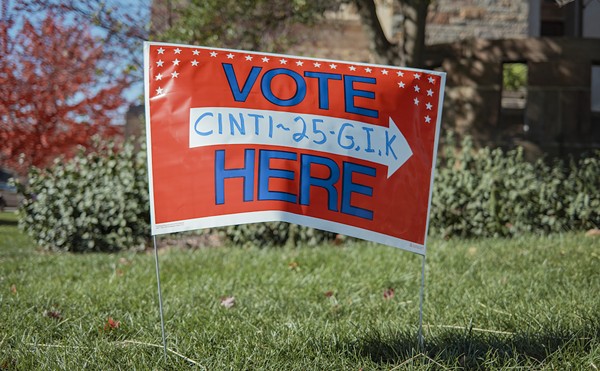Secretary of State Colin Powell stops at the National Underground Railroad Freedom Center before delivering his vote-for-President Bush speech to veterans gathered at the Cincinnati Convention Center, and he gives the Freedom Center a thumbs up. It's a welcome plug from a very public figure. Of course, no one bothered to ask Powell what the Freedom Center means.
Tolerance, diversity, democracy, respect and humane treatment towards others — these are the abstract themes at the Freedom Center's heart, whose inspiration will impact visitors uniquely, sending them in countless directions.
The Freedom Center is a welcome tourist attraction to some local supporters, the latest cultural attraction to boost downtown and riverfront development. To others — those who are idealistic about the transforming powers of history, education and art — the facility is a much-needed tool that can make Cincinnati better.
Both groups claim a brick or two hundred of the Freedom Center's three pavilions, which brings us back to the key questions weighing heavily on Powell or any other visitor, famous or not: What does the Freedom Center mean? What does it say to us beyond recounting America's slavery past and the Underground Railroad as an early step toward inclusive freedom for all people? If the Freedom Center could talk, what would it say?
Tackling complex issues through public exhibitions, theaters and learning centers are what quality museums often do best.
The Freedom Center isn't reinventing the wheel on the banks of the Ohio River. Rather, it's following the path of institutions like the Museum of Tolerance, an educational arm of the Simon Wiesenthal Center in Los Angeles, and the United States Holocaust Memorial Museum in Washington, D.C.
Like its famous museum peers, the Freedom Center aspires to offer a message of tolerance. How it supports that abstract message, especially when it comes to public artwork, remains a work in progress. It's not yet clear whether the Freedom Center trusts its visitors to craft their own ideas or whether it grants viewers the freedom to interpret what they're seeing and relate the images to the world outside the museum doors.
If art is non-specific — more symbolic than matter-of-fact — it can be a guidepost, the source of countless ideas and life-changing inspiration. The slave pen at the core of the building is a matter-of-fact reminder of intolerance. But does the Freedom Center's art have to be as simple as the pen in its storytelling?
Throughout the public grounds of the U.S. Holocaust Memorial Museum, the dialogue begins with Richard Serra's monolithic sculpture "Gravity," a 12-foot-square slab of steel that weighs nearly 30 tons. Joel Shapiro's "Loss and Regeneration" rest on an outside plaza. Inside a public lobby, visitors meet Sol LeWitt's minimalist wall drawing "Consequence," a series of large squares against backgrounds of varying colors. Elsewhere, Ellsworth Kelly's four wall sculptures, "Memorial," serve what the artist refers to as memorial tablets for all Holocaust victims.
There's nothing literal about the artwork at the Holocaust Museum, a forgotten value with much Freedom Center public art.
Freedom Center visitors will see six bas-relief limestone panels by Cincinnati artist Karen Heyl that tell the story of a family escaping over the Ohio River via the Underground Railroad. Local artist Brian Joiner created large-scale black-and-white acrylic portraits of influential artists such as Bob Marley, Cicely Tyson and Harry Belafonte.
On Wednesday, Kentucky sculptor Wyatt Gragg unveils his bronze figurative work, "Freedom," a half-size reproduction of a mother and child escaping from slavery. The sculpture is a gift from Northern Kentucky donors, and plans call for it to be installed inside the Freedom Center, although Gragg — on the eve of his arrival — is still unsure where that will be.
His sculpture will join a folksy quilt by Jane Burch Cochran, "Crossing to Freedom," and a large fabric wall sculpture by Columbus, Ohio, artist Aminah Robinson. These colorful works tell the same freedom story, perhaps more powerfuly because they're less narrative in nature.
Art doesn't need to be easy to understand or approachable to make its impact, even in matters as complex as freedom. It shouldn't be the same as a slave pen transported from a Kentucky farm.





